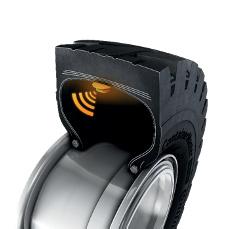
23 minute read
Emission Reduction
LOW EMISSIONS STRATEGY
As ports look for ways to cut their emissions, management teams are faced with a bewildering choice of low emissions technologies, and the risk of implementing a technology that might become obsolete. Steve Roberts, Associate Director, Ports & Marine, AECOM, looks at how to navigate the options and fi nd not only the best option technologically, but strategically
Environmental credentials have never been more important in the transport sector, and society as a whole, than now. Globalisation was driven by cost reduction and maximised the comparative advantage of diff erent economies creating a boom in seaborne trade in the process. This model only accounts for the direct fi nancial costs of production and shipping, and not the wider externalities such as environmental impacts.
Today, shippers, striving to meet customer expectations of environmental responsibility, increasingly look for ‘green’ supply chain options with lower emissions. Some leading port groups have successfully differentiated their offering on this basis, with the reward that customers attracted by this attribute tend to be more captive.
There is also the opportunity to reduce operating costs by adopting low emission technologies, both from fuel and maintenance cost savings, and there may also be possibilities for ports to generate revenue.
VARIOUS SOURCES
Ports are built on complex systems of operation and consequently reducing or eliminating port emissions is a complex affair. By default, most ports use at least two power sources (electricity and diesel) and sometimes more: LPG for forklift trucks, petrol for road vehicles, and if bunkering for vessels is provided other fuels enter the equation.
An immediate question for anyone devising a low emissions strategy is: which technology offers the best emission reduction and financial return (including consideration of whole-life costs)? To arrive at the answer, ports must consider which technologies currently on offer will be available over the next 10 or 15 years - the typical lifespan of port equipment that today cannot be fully or easily electrified. This, in turn, begs the question, is technical superiority the key to predicting which power source will gain the critical mass needed to become mainstream, and how much does that matter for your port? To help address this issue we consider some of the strategic, rather than technical, considerations.
For port systems such as buildings, supplying shore power to ships or bunkering of vessels lower emissions can be achieved through the purchase (or on-site generation) of renewable electricity, providing shore supply to ships if grid capacity permits, or provision of LNG as a bunker fuel. For these asset types, the best options are fairly clear-cut.
For cargo handling equipment electrification appears to offer an ideal solution to many problems: eliminating on-site emissions and if supplied from renewable sources eliminating emissions altogether. While this is a good option for assets such as ship-to-shore and yard cranes, items such as terminal tractors, payloaders, reach stackers, empty container handlers and so on (‘mobile equipment’) remain difficult to electrify with current technology. Mobile equipment has the common characteristics of being mobile, subject to weight limitations, and having usage patterns that mean they have little downtime. It is this area of port operations where identifying the best low emission option is most complex.
For these situations alternative energy sources and technologies may be the answer. Alternatives to fossil fuels such as diesel include: 5 Electrification with cable connection 5 Battery electric power 5 Fuel cell electric power e.g. hydrogen fuel cell 5 Liquified natural gas (LNG) 5 Hydro treated vegetable oil fuel 5 Petrol or diesel hybrid drives 5 Biodiesel fuel 5 Hydrogen duel fuel 5 100% Hydrogen internal combustion engines
They offer varying: 5 Reductions in emissions 5 Capital, fuel and maintenance costs 5 Retrofit capability for existing vehicles and plant 5 Suitability for different applications in ports 5 Availability
These alternatives can also be categorised as either: 5 Fully aligned to traditional internal combustion engine technology, e.g. biodiesel or 100% hydrogen internal combustion engines, 5 Partially aligned with internal combustion engine technology, e.g. hybrid drive technologies, or 5 Aligned with electrical power, e.g. fuel cell options, battery vehicles and pure electric options
DECISION MAKING
When creating a low emission strategy the following strategic factors should be weighed up in addition to the technical reduction in emissions and direct costs:
8 Mobile cargo
handling equipment presents the biggest challenge when seeking to identify the best low emission power source
Keeping things simple 5 How many different fuels and technologies do we want to be operating with? Each additional fuel, energy source or unique type of technology potentially adds: space requirements; inventory costs, training costs, and may require permitting for on-site storage. A non-standardised fleet also reduces flexibility and the ability to cover equipment breakdowns or staff shortages. Fewer different fuels and technologies will generally be easier and cheaper to manage.
Obsolescence or unfavourable perceptions in the future 5 Will other technologies become suitable for this application in the future? Some alternative fuels have shown promise and been used in pilot schemes but did not become as widespread as expected. Electricity is the most commonly convertible type of energy and used in the final drive of hybrid vehicles, fuel cell vehicles and battery electric vehicles, so technologies that incorporate electrical drives may suffer less obsolescence. 5 Does the technology result in a genuine reduction in emissions or does it create a new environmental problem elsewhere in the energy supply chain, or in the lifecycle of the equipment? The green credentials of biomass power stations are now being questioned as the notion of shipping wood chips from one continent to another, and the ability to re-plant sufficient trees at a fast enough rate, has already put some investors in the port sector off backing this technology in the future. Equally relevant, while battery electric vehicles potentially offer zero emissions at point of use and during power generation, battery waste at the end of vehicle life is still an open question. 5 Are there ethical considerations over how the fuel is produced? Is there potential conflict between the production of the fuel or manufacturing of the technology and resources such as water, land for food production, or waste from mining? Today this may seem a small concern, but how could it look in 10 years’ time?
Implementation and operation 5 How does the technology match the duty cycle of the application? Does the refuelling/recharging time coincide with periods the equipment is not in use, both in terms of frequency and duration? This may depend on specific usage patterns at a port rather than a general characteristic of a given type of equipment. 5 How easy is it to implement? Does the technology require large amounts of infrastructure within and outside the port such as fuel tanks, pipelines or upgraded grid connections?
What investment in training is needed for staff, and how easy is it to source people with the right skills? What licences may need to be held? How dependant is implementation on the actions and cooperation of third parties? What are the space requirements? In general, small scale self-contained schemes will be easier to implement. 5 Scaleability – how easily can the technology be further rolled out if volume growth requires more equipment? Are there ‘tipping points’ that need to be reached before an increase in fleet or infrastructure makes financial sense for a given technology, and if so how big are the steps between tipping points?
Long term viability and lower unit costs 5 Will there be long term support and widespread adoption of this technology? What evidence is there the technology is gaining critical mass, at least at a local level? 5 What might happen to energy prices in the long term? This is hard to predict but as a general rule if something is widely adopted costs should come down in the long term. It is worth considering: can the energy be generated from a variety of sources and are those sources spread throughout the world? If so, unexpected price increases due to natural disasters, conflicts, loss of refining capacity, or cartels are less likely. Taxes on fuels should be viewed carefully: if currently higher taxed fossil fuels are largely replaced in the long term, how will governments replace this revenue?

Risks 5 What are the sunk costs if the technology proves unreliable and conventional equipment has to be brought back into use? And what are the consequences of disruption caused by equipment failure? 5 What are the options for leasing rather than purchasing?
Or for suppliers to fund some or all of the infrastructure? 5 If fixed infrastructure needs to be introduced, is there a risk of siting it in a location that inhibits future development plans?
Upsides 5 Can this energy source also generate revenue for the port?
Could the energy source be located in the port and any excess sold to third parties? Could the port be a hub for distribution or retailing of this fuel – even if generated by a third party – with a rent or % of sales creating a revenue stream for the port?
A LOGICAL PATH
As with most things, there is likely to be a trade-off between cost and benefits. The greater the investment the more crucial it is to de-risk the strategy by choosing options likely to be reliable, simple to implement and become widely adopted. Options that incorporate electric drives and fuels such as hydrogen which is both non-polluting at point of use, can be produced using renewable electricity (creating ‘green’ hydrogen), and does not appear to conflict with other human needs; are likely to be safer long term choices. However, hybrid drive or battery electric solutions may be more appropriate given the scale, equipment lifespan and space constraints of an individual port.
What is most suitable will depend on the specific circumstances of each port. A wide range of strategic considerations and a systematic decision-making process should guide development of a low emission strategy for ports.
8 The greater
the investment the more crucial it is to de-risk the low or zero emission power source selection
TERMINAL TRAILERS: EVOLVING
Longevity, strength and value are key trailer requirements for marine terminal operations. John Bensalhia looks at some of the notable products and innovations to make the grade this year
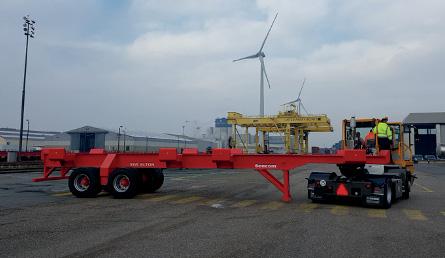
As the old maxim goes, “You get what you pay for.” Steff en Kohleisen, Sales, Seaports and Container Terminals, Seacom AG, is discussing the longevity of port trailers and their components. “If you want a port trailer to last a long time, you have to invest in high quality components: steel quality, suffi cient dimensions of I-beams, heavy-duty axles and bearings, quality-brand tyres, and high-quality paint.”
Clearly, marine terminals seeking the right trailer need to consider a wide range of requirements. Strength, longevity, safety, value for money, ease of use and speed are all identified as primary requirements. Accordingly, trailer manufacturers are providing solutions for diverse unit loads.
CORNERLESS IS KING
Recent trailer design trends have accommodated the latest requirements with facilitating fast turnaround high on the list. With this in mind, terminals are opting for solutions like the cornerless chassis.
“Over the past few years, cornerless chassis have become more and more popular, as this design allows the quickest turnaround time,” says Kohleisen,
He explains that drivers can pull away from the crane as soon as the spreader has lifted off, since containers do not need to be secured. “Gravity stoppers prevent smaller containers from shifting during transport. Terminal trailers are typically rated for speeds up to 25 km/hr.”
Cornerless chassis are becoming popular as the design offers enhanced ‘‘ turnaround times
Self-locating guides are also identified as a performance enhancing asset – as featured, for example, on CIMC’s 45ft Port Terminal Skeleton Trailer. Designed to carry one container up to 45ft, this skeleton trailer includes a clearly marked self-locating guide in order to hasten the level of container loading onto the chassis..
CHALLENGING CONDITIONS
When investing in a trailer, operating conditions are also important to consider. Freezing conditions can prove to be a challenge for equipment, so finding a trailer that can withstand elements such as snow, ice, and rain is essential.
In June 2020, it was announced that the Port of Montreal’s Viau and Maisonneuve terminals would be taking delivery of new Buiscar trailers. The units were selected on account of their ability to withstand the -30 degree Celsius climate of a harsh Montreal Winter season. The design of the Buiscar trailer features high tensile, hot rolled steel main beams for the base, with a load capacity of 70 tons and the ability to move containers of up to 45ft in length.
Another reported benefit of the Buiscar platform configuration’s main beam wide design is that it features integrated collapsible twist-locks which enable any loaded containers to be secured in various positions. A recent skeletal trailer of this kind was constructed for an Antwerp-based customer in July 2020, with the capability of handling 20ft and 40ft containers with a 65 ton load capacity.
In April 2020, four skeletal trailers were provided for an Icelandic-based customer. The trailers are employed at a terminal that conveys containers and bulk cargo between various modes of transport including ships, trucks and trains. The trailers accommodate containers between 20ft and 45ft with a load capacity of up to 65 tons.
8 Ports seeking
the right trailer need to consider a wide range of requirements: strength, longevity, safety, value for money, ease of use and speed are high on the agenda
In July 2020, China’s Shandong TITAN Vehicle Co., Ltd delivered to Tanzania a 40ft container port terminal semi-trailer design that comprised a truck chassis for both loading and unloading heavy containers with ease. The semi-trailer is made from high tensile-strength steel to ensure longevity, while the main beam of the trailer is strengthened via TITAN’s automatic arc-submerging welding procedures (a flexible product that can be adjusted to specific moving conditions for both loading and unloading).
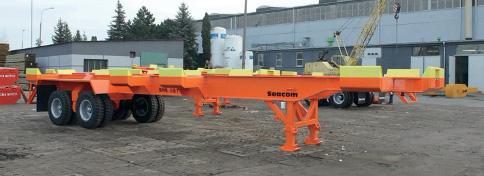
NEED FOR STRENGTH
In terms of safety, port trailers need to be extremely rigid and heavy duty. Kohleisen explains that compared to regular road trailers (which are being carefully loaded, then driven for several hours before being unloaded again), port trailers are constantly loaded with heavy containers with significant impact forces.
“Often, containers are being placed on a chassis with a substantial impact, and when loaded with a twin-spreader, two containers with a combined weight of 65 tons, plus the weight of the spreader, must be supported. This means that container guides, main frame beams, axles and rocker beams must be extremely rigid. Leaf suspensions or air suspensions, which are widely used in the transport industry, are not suitable for port operation,” Kohleisen underlines.
Trailer strength is also essential to facilitate efficient cargo handling. To avert wear and tear of both the cargo unit and the trailer, modern trailer designs are made with extra strength. The CIMC Tri-Axle 40ft Flatbed Trailer with Side Wall includes a reinforced tray box that is designed to prevent the risk of deformation when the trailer is fully loaded. Capable of holding either 1 x 40ft container or 2 x 20ft containers, the Tri-Axle trailer while of a heavy duty design it is, thanks to the cornerless chassis, still relatively easy to manoeuvre.
NEW GENERATION TECHNOLOGY
Electric vehicle and trailer combinations have already been devised, tested and used as a means of saving energy and using a trailer in conjunction with a fully electric tractor points the way forward for to meeting modern-day environmental requirements.
One manufacturer embracing this concept is Gaussin. Earlier this year, Gaussin confirmed an order with New Zealand-based CentrePort for seven fully electric terminal tractors and seven TT terminal trailers. The container handling tractors are powered by Lithium Metal Polymer (LMP) batteries, which reduce emissions and noise pollution levels to zero and are claimed to simultaneously boost levels of safety, driver comfort and productivity.
The effectiveness of this alternative technology trailer/ tractor combination was verified in March 2020. Global freight and logistics company, UPS, tested six Gaussin electric vehicles for performance and strength when moving semitrailers and containers. The Trailer and Swap Body Mover combination is said to have a number of advantages. As well as zero emission levels, the battery-swap technology used means that when one battery goes flat, it can simply be swapped for a fully charged one. This, it is said, offers a key benefit for port operators because tractor and trailer cargo handling can be performed on a constant basis, 24/7.
The UPS test results further confirmed that autonomous tractor/trailer driving can deliver significant economies.
And with added strength, resistance to damage and flexibility, port operators seeking an optimised design look to have moved a step closer to this.
8 Port trailers need
to be extremely rigid and heavy duty so as to withstand strong impacts up to 65 tons, plus the weight of the spreader in conjunction with twin-lift operations
Tyres two key considerations
A fundamental aspect of the trailer is the tyre. In order to ensure maximum protection of trailer tyres, terminal operators must ensure two important elements, as Kohleisen outlines.
“Ports need to ensure that they buy quality. Good quality tyres are essential for safe operation of the terminal chassis. Seacom only uses quality brand tyres on its trailers and are not offering cheap no-name tyres. On dual axle chassis, regular road tyres can be used, but for single axle chassis we use special terminal tyres or industrial tyres with a high load rating (PR24).”
However, even the best quality tyres will not last for long if the tyre is under inflated, which can quickly become a safety issue. “On a fully laden chassis, a tyre failure can result in a roll-over of the chassis,” explains Kohleisen. “It is, therefore, essential to check the tyre pressure daily. Seacom’s design features a heavy-duty rocker beam with stub axles, where both tyres are mounted in twin configuration, thus both tyres are easily accessible from the outside of the chassis.”
The Continental Trailer Tyre is designed with maximum wear volume for high mileage and a long lifespan. As well as a high loading capacity and low rolling resistance, the tyre design allows for low vibration (adding extra comfort for the driver) and greater reliability for ports, owing to less tread edges compared to a profiled pattern.
A wide variety of tyres from Emerald Tyres caters for many kinds of cargo trailer. These include tyres for bomb carts, flat deck trailers and ro-ro trailers. The tyres are made with a heavy duty compound that increases safety, strength, efficiency and value for port operators. A further degree of flexibility is afforded in a choice of sizes for different port trailer requirements.
TYRES TREAD A POSITIVE PATH
Tyre design for port operation continues to advance. John Bensalhia identifi es the latest initiatives
While there is a greater shift towards energy-saving, emission-free port equipment, a side eff ect of this is that it can place extra demand on key items of equipment, such as tyres.
A document released by the Port Equipment Manufacturers Association (PEMA) notes the issues that tyres face with respect to automation and alternative energy technology.
It says that with a sizeable number of ports shifting towards automated operations and/or non-fossil fuel power sources like batteries or fuel cells, this can potentially place larger demands on vehicle tyres.
The report further explains that this is due to greater acceleration and sharper braking brought on by electric battery units and automated equipment. Compare this with the traditional style of cargo handling vehicle – while there’s less pressure on tyres, there’s a greater emphasis on fossil fuel use.
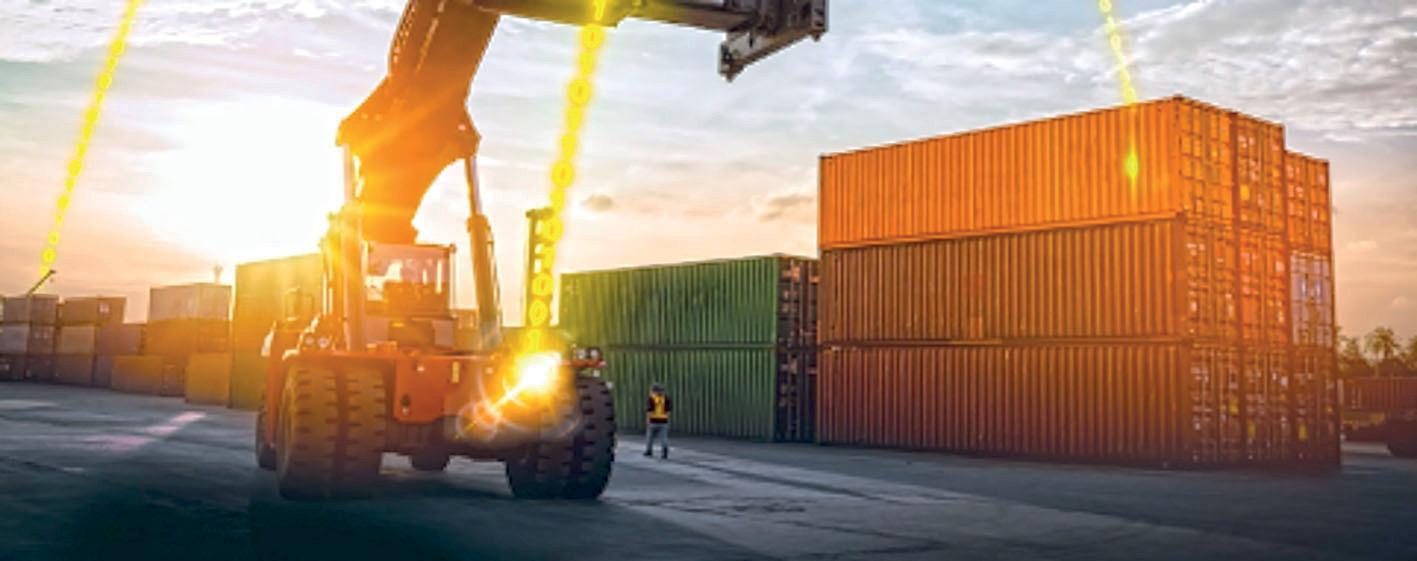
ALLEVIATING THE QUANDRY
In order to alleviate this type of quandary, tyre manufacturers are introducing products and solutions that are designed to cope with modern day demands.
“One of the main trends in ports today is the trend towards automation,” confirms Anika Hannig, Head of Marketing Communications, Commercial Specialty Tyres, Continental Tyres. “If you have a look at the types of machinery being used in today’s ports, you will find an increasingly high number of AGVs. The use of automated machinery affects all components, including tyres.”
Hannig says that there are two things to consider. Positively, an impact of the driver’s behaviour on factors such as wear and tear of the tyre become obsolete, but negatively there is a need for automated checks of the tyre’s health where there is no longer a driver present to manually check them.
“This remains very important as the wrong air pressure is not only one of the biggest causes of premature tyre failure, it also offers another significant benefit,” she confirms.
DEMANDS ON TODAY’S TYRES
As well as the growth in automation, tyre manufacturers are responding to other new requirements from port operators.
“Reliability and stability when operating with heavy loads are common demands placed on today’s tyres,” says Rosanna Kivinummi-Lahdenpohja, Marketing Manager, Nokian Heavy Tyres, adding, “Today’s notable trends in tyres when operating in ports and terminals are safety and stability in all conditions. In addition, the combination of intelligent sensors and tyres to support economical, efficient and safe use of tyres.”
Hannig adds that there are two more major demands: a low wear rate of the tyre and the lowest total cost of ownership. “To address these demands, it is crucial to have a look at the specifics of the different vehicles and different applications – especially at times where machines develop, and vehicles are providing more variable functions.”
Hannig further explains that Continental distinguishes different operational tasks – such as pick and stack applications or load and carry applications. “Vehicles such as reach stackers are used to load and unload containers,” she says, before confirming, “There is a lot of short distance driving with a high volume of turning on the spot. At Continental, we offer V.ply tyres for this kind of application. They are the right choice for such applications, as they reduce heat generation and abrasion, the two primary causes of tyre wear, to significantly extend tyre life – and therefore to reduce costs.”
REDUCING WEAR
Another means to reduce tyre wear is the compound. “Tyres have to adapt to changes in vehicle design,” says Hannig. “Manufacturers are making vehicles more compact now so they can work in narrower spaces. This means the axles are much heavier than they used to be, which means we needed to make the compound more resistant to tearing and wearing. At Continental, we launched our Port Plus compound with improved wear performance in 2018 to meet these demands by reducing tyre heat generation, minimising wear and consequently extend tyre life significantly.
Nokian Tyres has also established solutions to ensure tyre strength and lower risk of wear and tear. “We have developed rubber compounds to prevent accidental tyre damages and to extend the operating hours of the tyres,” says the company.
Examples from this manufacturer include tyres that can
8 Tyre producers
continue to meet new design challenges in the ports sector
cope with the challenges of heavy loads and extreme weather conditions. The Nokian Hakkapeliitta Truck E2 tyre is designed to manage thick snow and slippery ice.
Teppo Siltanen, Product Manager, Nokian Tyres, explains that the new tyre has a number of special features that make movement much easier in bad weather. “Nokian Hakkapeliitta Truck E2 has better stability as well as grip in both deep and packed snow. Also, the grip lasts longer, thanks to some clever tread pattern features.”
Also, Nokian’s R-Truck Steer XL is a tyre designed to cope with heavy stresses. Siltanen explains, the tyre can cope with “the heaviest construction and timber trucks...” We want, he adds, to open up new possibilities for heavy trucks. The Nokian R-Truck Steer XL tyre brings good off-road properties to a new weight class. The open tread pattern and wide grooves mean that the tyre has a solid grip for controlled steering in all kinds of driving conditions. When used on rough surfaces, the stone ejectors in the tyre grooves ensure a long lifespan, which is also prolonged by the tyre’s rubber compound, resulting in low heat build-up and slow wear.
EXTRA RESISTANCE
Considering challenging port handling environments, Trelleborg’s T-900 and TR-900 tyres include a number of aspects that are designed to make operations easier. The T-900 includes a reinforced sidewall that provides extra resistance to sudden side impacts. Stability and traction are boosted, thanks to the T-900’s extra wide tread. Meanwhile, the TR-900 tyre is designed to reduce the build-up of heat, helping to extend its life-cycle, and thus, save the port operator money.
The Magna ranges of tyres are designed with the same principles in mind. Specially created compounds ensure improved stability and longer lifetime. The Magna MB01’s wear-resistant tread compound has been made to avoid tyre cracks and provide an extended life-cycle. It is reported to be a tyre that offers reinforced support capability and a low level of heat generation, adding to its longevity.
Geared towards straddle carrier use, Magna’s M-Straddle+ is said to be able to increase a load rate by seven per cent due to its reinforced casing. It is also claimed that a straddle
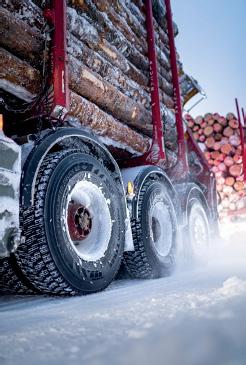
carrier driver can experience greater comfort and boosted dynamic stability, thanks to the strong rib pattern of the M-Straddle+. Plus, the tyre is said not to get too hot due to special heat dissipation feature.
Modern day tyres are widening their horizons. In order to better reflect the broad choice of applications that it is suitable for, Continental has recently renamed one of its port tyres formerly known as StraddleMaster+ to TerminalMaster V.ply.
“In this way, the name of the tyre is not only limited to use on straddle carriers, it also includes use generally in industrial heavy-duty transports,” says Hannig. “Further, the name also shows the construction type of the tyre which is based on multiple layered high resistance polymer fibre construction.
According to Continental, the proven V.ply tyre portfolio offers a high degree of stability with excellent turning on the spot conditions, strong sidewalls and new abrasive and crack resistant compound.”
Remote monitoring, simulating for optimum design… m design…
Hannig explains that digital tyre monitoring systems like ContiPressureCheck and ContiConnect help operators of automated fl eets to achieve an overview of the pressure and temperature of each tyre deployed.
“If a value deviates from the recommendation, it automatically warns, and a fleet operator can stop the vehicle and adjust the pressure and temperature before a tyre failure happens,” she explains.
Modern technology is also being used to devise ways of testing the strength of new tyres. Continental uses virtual as well as real testing.
“Virtual prototypes and 3D testing in our simulation lab help us to simulate the actual use of the tyre and its behaviour when used in real applications,” says Hannig.
She explains why this is a benefit. “The range of parameters that can be analysed during such simulations reaches from deformation and deflection behaviour under load to heat development when driven at higher speed. With the help of virtual testing, we are able to reduce the number of development cycles for the sake of a fast development and delivery of our tyres to the customer.”
8 Tyre
strength is one of a number of design elements Continental assesses via simulation
8 Tyres have to
cope with heavy stresses and challenging port conditions
